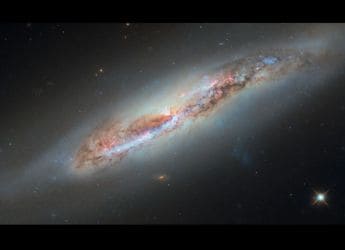- Home
- Science
- Science News
- NASA's James Webb Telescope Renders Awe Inspiring Pillars of Creation With Greater Depth, Clarity
NASA's James Webb Telescope Renders Awe-Inspiring Pillars of Creation With Greater Depth, Clarity
NASA's spellbinding images show vast, towering columns of dense clouds of gas and dust where young stars are forming some 6,500 light-years from Earth.

Photo Credit: NASA
Webb infrared telescope was launched into space on December 25, 2021
One of the most celebrated, awe-inspiring images of modern astronomy, revealing colossal spires of interstellar gas and dust called the Pillars of Creation, has been rendered anew with greater depth, clarity and colour by the James Webb Space Telescope.
The new view of the pillars, first made famous when captured in 1995 by Webb's predecessor observatory, the Hubble Space Telescope, was unveiled by NASA on Wednesday, three months after Webb's inaugural batch of cosmic photos was unveiled as it began full operations.
The spellbinding images show vast, towering columns of dense clouds of gas and dust where young stars are forming in a region of the Eagle Nebula, in the Serpens constellation, some 6,500 light-years from Earth.
The image became a worldwide cultural phenomenon, emblazoned on to everyday objects ranging from T-shirts to coffee mugs.
Revisited by Hubble's visible-light optics to create a sharper, wider scene in 2014, the pillars were rendered by Webb in the near-infrared spectrum with even greater translucency, bringing many more stars into view while revealing new contours of the gas-and-dust clouds.
The new view "will help researchers revamp their models of star formation by identifying far more precise counts of newly formed stars, along with the quantities of gas and dust in the region," NASA said in material accompanying the latest image.
Bright red orbs appearing just outside of the pillars are infant stars, where enormous knots of gas and dust have collapsed under their own gravity and slowly heated up, giving birth to new stellar bodies, according to NASA.
Wavy crimson lines that look like lava at the edge of some pillars are ejections of matter from stars still forming within the gas and dust and are estimated to be only a few hundred thousand years old, the U.S. space agency said.
Nearly two decades in the making under contract for NASA by aerospace giant Northrop Grumman Corp, the $9 billion (roughly Rs. 75,000 crore) Webb infrared telescope was launched into space on December 25, 2021, in partnership with the European Space Agency and the Canadian Space Agency.
It reached its destination in solar orbit nearly 1 million miles (roughly 16,10,000km) from Earth a month later and is expected to revolutionize astronomy by allowing scientists to peer farther than before and with greater precision into the cosmos, to the dawn of the known universe.
© Thomson Reuters 2022
Get your daily dose of tech news, reviews, and insights, in under 80 characters on Gadgets 360 Turbo. Connect with fellow tech lovers on our Forum. Follow us on X, Facebook, WhatsApp, Threads and Google News for instant updates. Catch all the action on our YouTube channel.
Related Stories
- Samsung Galaxy Unpacked 2025
- ChatGPT
- Redmi Note 14 Pro+
- iPhone 16
- Apple Vision Pro
- Oneplus 12
- OnePlus Nord CE 3 Lite 5G
- iPhone 13
- Xiaomi 14 Pro
- Oppo Find N3
- Tecno Spark Go (2023)
- Realme V30
- Best Phones Under 25000
- Samsung Galaxy S24 Series
- Cryptocurrency
- iQoo 12
- Samsung Galaxy S24 Ultra
- Giottus
- Samsung Galaxy Z Flip 5
- Apple 'Scary Fast'
- Housefull 5
- GoPro Hero 12 Black Review
- Invincible Season 2
- JioGlass
- HD Ready TV
- Laptop Under 50000
- Smartwatch Under 10000
- Latest Mobile Phones
- Compare Phones
- OnePlus 15R
- Realme Narzo 90x 5G
- Realme Narzo 90 5G
- Vivo S50 Pro Mini
- Vivo S50
- OPPO Reno 15c
- Redmi Note 15 5G
- Redmi Note 15 Pro 5G
- Asus ProArt P16
- MacBook Pro 14-inch (M5, 2025)
- Infinix Xpad Edge
- OnePlus Pad Go 2
- OnePlus Watch Lite
- Just Corseca Skywatch Pro
- Acerpure Nitro Z Series 100-inch QLED TV
- Samsung 43 Inch LED Ultra HD (4K) Smart TV (UA43UE81AFULXL)
- Asus ROG Ally
- Nintendo Switch Lite
- Haier 1.6 Ton 5 Star Inverter Split AC (HSU19G-MZAID5BN-INV)
- Haier 1.6 Ton 5 Star Inverter Split AC (HSU19G-MZAIM5BN-INV)

















